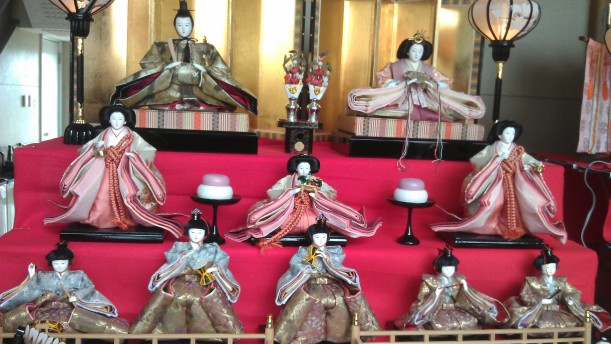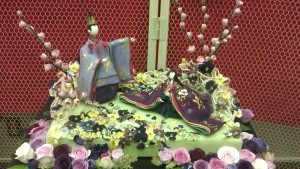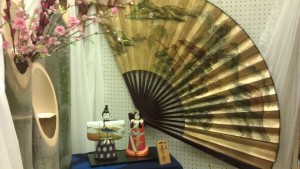Spring is swelling
Is that blossom I see?
White snow
Hanging on the branches
Where the warbler sings.
(The Monk Sosei, Kokinshuu)
First, a tiny tiny disclaimer: this post is written by a very tired, and a bit chaotic mind. I figured, it’s better to make blunders on the way than to give up the habit entirely! The last couple of days have been full and captivating. There were probably many stories to tell, but they might have eaten each other in my memory as they happened, and the remainder, sad and scared, were probably eaten too by sleep. Those that do persist will find a strange kind of immortality in this experiment-blog-free-writing. What a fate for them, not to have found a proper writer! Enough chit-chat, for duty (and literary desire) calls.
Our teacher in the last days was perhaps my favorite (or dare I say our favorite?). With a persistent good humor, kind smile and clever associations of words and ideas, Ogano-sensei also embroidered knowledge into stories and symbols, of words, of kamis and of beliefs, so that we did not feel the morning pass. He also brought us detailed handouts with graphics, maps and images, but even 1000 year old ceramic and hundreds year old relics from temples, like various instruments used in purification or to drive away the bad spirits, or population registration documents, or an old calendar! Really, I feel unworthy of such a closeness to the testimonies of history.
Among other things, he told us about the role of religious organisations in the Edo period, how they came to be involved in population registration and also developed a tax system, the role of Onshi 御師, the promoters of religious pilgrimage, as of their rise and fall (for a much more detailed and coherent explanation please check out Avery’s blog 🙂 ). What captivated me most of all were, as always, the stories related to Shinto and mythology. No matter how much I tried, I could never think of Shinto as an “alive religion”, probably also because it’s so different, with its animistic features and its thousands of kami, but listening to Japanese people talk of it and watching documentaries about matsuri (celebration) performed, I truly do start to see it. And I marvel at it.
As such, we discussed again where the name Ise comes from – this time we thought it comes from Iso, through euphony, which also meant ‘place near the sea’ though. The more mysterious part was, if we put the myth aside, of the vision of Amaterasu had by Princess Yamato, why was Ise chosen as a place to worship Amaterasu in the first place? Here the explanation of the teacher juggles playfully between the profound, poetical considerations and the astounding linguistic associations. As such, it is known that there is a connection between the kanji for sea 海 and the kanji for mother 母, and the sea itself has a mother-like quality for the Japanese. In the end, all life could be said to come from the sea, also following the theory of evolution. According to a more primitive imagination, the sun also rises from the sea. Therefore, it would seem that the sea truly is the origin of all things. Amaterasu, the supreme goddess, is the goddess of sun – which is also the supreme god in many cultures, like the Egyptian Ra, or the Greek Apollo, or in the Incan culture (or actually also in Romanian folkor beliefs as uttered by my grandmother). “Because Amaterasu is so splendid, she is also far and high, and we cannot reach her”, says our teacher. And as all things, including the sun, are born from the sea, what better place to worship Amaterasu than the place of her birth? Thus, Ise was chosen, as the land near the sea. Another (poetical) explanation was that in the vision of Yamato-hime (the Princess Yamato), she was told to find a beautiful land (country) 美し国 (umashi kuni) and what was meant by that was a land with people with a beautiful heart/mind 美しい心 (utsukushii kokoro), which is what Ise has the most of, according to our teacher, and much more important than the scenery, the shrimp or anything else.
We let ourselves be delighted, and afterwards be carried away to various places in which we also learned the history of salt (it sparked my interest that the place for the processing of salt was also the shrine, which begs a question about the connection between salt and the idea of purification in Shinto). We also stopped to visit buildings and shops which proudly exposed their collection of Hinamatsuri dolls. On the 3rd March there is the so-called ‘festival of girls’ or ‘festival of dolls’, in which every family reveals their dolls, a miniature representation of the imperial family. It is perhaps a bit strange how loyalty and devotion, and such important, almost-sacred figures as those of the imperial family, are represented in playful symbols. Long ago there was also a tradition of placing dolls made of paper or straws in a basket to float on a river, in hopes that they would also take the problems of the girls with them, and protect them from evil spirits.
// for soundtrack click here
Last, but not least, we reached our final destination: Okitama or the meoto iwa, ‘wedded rocks’ (the ones in the main picture above this post). They are said to be husband and wife, or father and mother, and the shimenawa rope between them symbolizes that the place is a dwelling of kami. It is probably one of the many iconic images of Japan, or of Shinto at least. They say that in very clear days you can see mount Fuji-san in the distance between them. The shrine there is dedicated to receiving prayers for the opening of a road, for the well-being of a family, and for a good marriage. It is also a well-known place for the start of the pilgrimage to Ise, where people would purify themselves in the water next to the rocks. The kami enshrined at the shrine just on the shore are: Sarutahiko no kami, Ukanomitama no kami (Ama no iwato), and Watatsumi no kami (in the Ryugusha). Sarutahiko is the kami who has guided Ninigi-no-mikoto in his descent from heaven to the island of Kyushuu, and it is believed that he originated as a deity from Ise. Ukanomitama is a kami associated with grain, especially with rice, while Watatsumi no kami, belonging to a shrine near the rear entrance to Futami (the area) is a kami of the sea, or the ‘dragon god’, the approximate equivalent of Poseidon. The palace named Ryuguujou, where he resides underwater, is of Chinese provenance and bears multiple meanings of its own. I am very glad to have been there, as I dreamed of seeing the rocks for a long time, and it surprises and delights me that the place also bears a connection to Watatsumi, who appears in many fairy tales, like the one dear to me, the story of Urashima Taro.
P.S.: On a far less serious note, today I received my first nickname (or my first kind nickname anyway!). As I have become notorious among our group in the student dorm for trading from our ‘breakfast basket’ the yogurt or milk with apples (as I love all fruits and apples among them), my friend Jenny has ‘baptized’ me as ringo no hime (ringo means ‘apple’, no is a particle which marks possesion, and hime means ‘princess’). So I am now the… princess of apples? I think of Momotaro (the boy born from a peach in the Japanese fairy tale with the same name) and of Thumbelina (born from a tulip), of H. C. Andersen’s fairytale and my mind keeps playing with the words among the same lines – a princess born of an apple, an apple who traveled the world… oh my, how I get carried away. Every time my lips form my nickname they cannot help but smile. Such is true happiness, uncalled, unnoticed and light as a butterfly.


